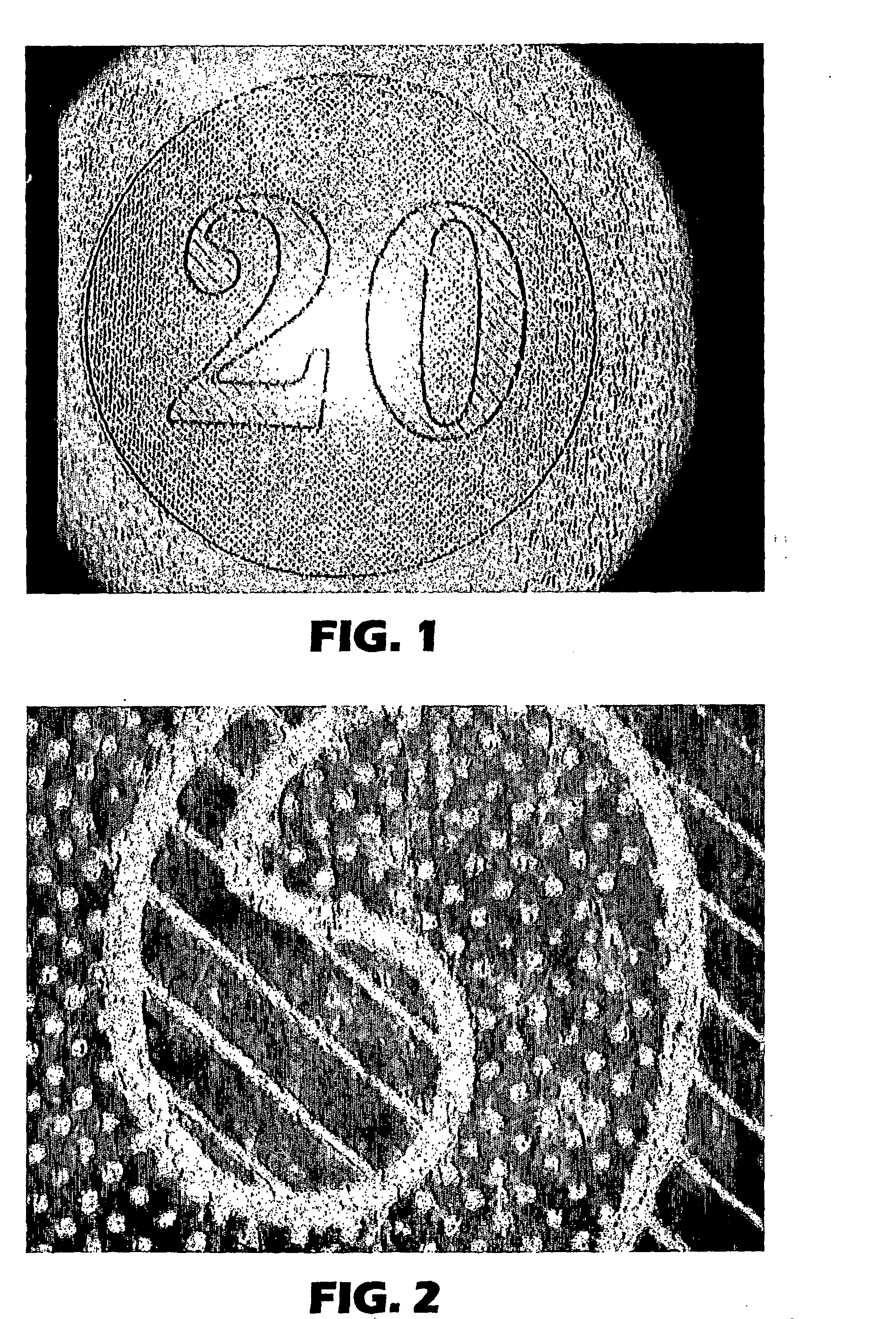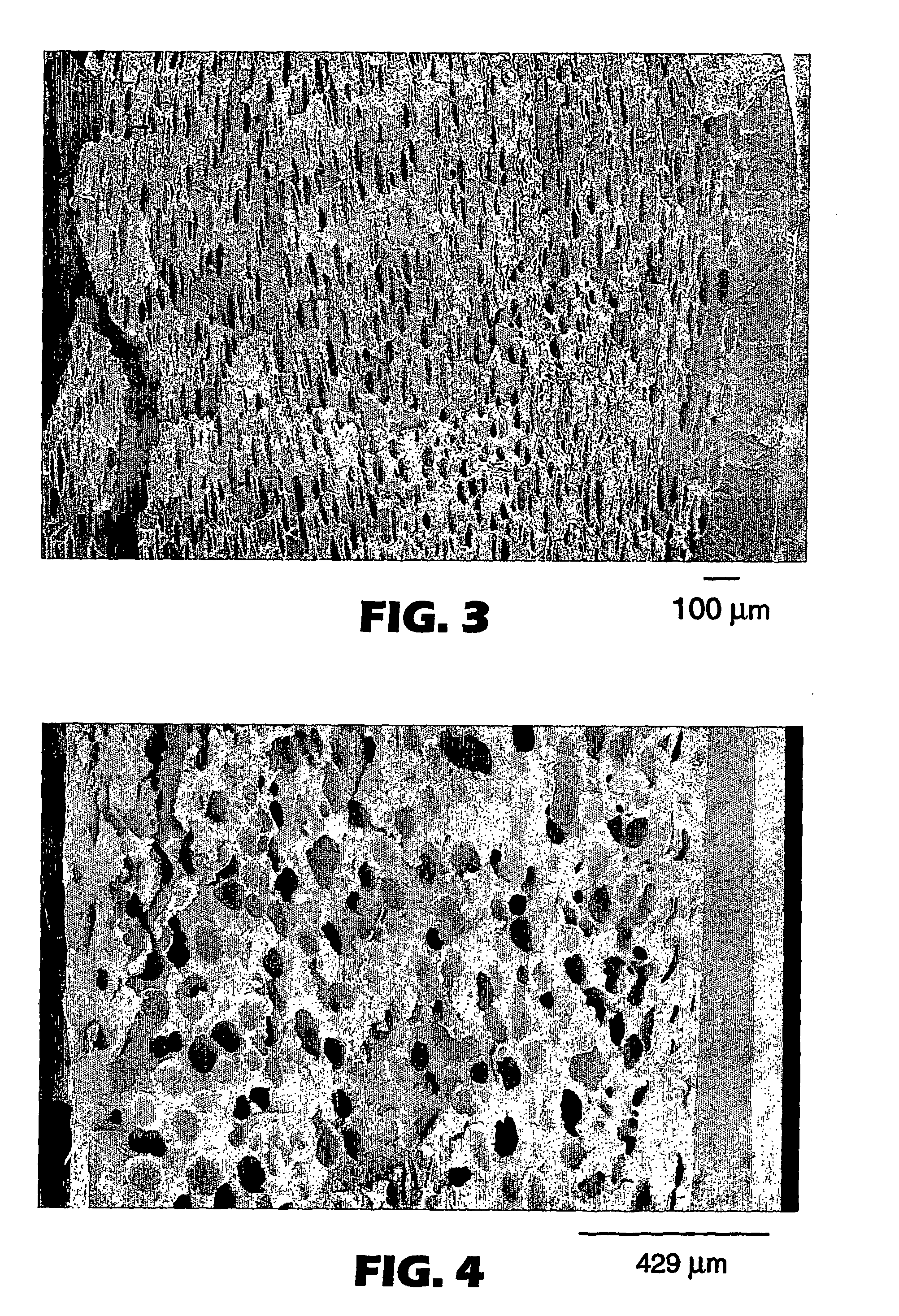Ink-receptive foam article
a technology of foam article and ink, which is applied in the field of ink-receptive foam article, can solve the problems of inability to absorb ink, lack of inherent capacity of film material, and inability to meet the needs of image-forming ink on polymeric substrates, and achieve the effect of increasing the crystallinity
- Summary
- Abstract
- Description
- Claims
- Application Information
AI Technical Summary
Benefits of technology
Problems solved by technology
Method used
Image
Examples
example 1
[0151] A melt mixture of 67% high melt strength polypropylene (Profax PF814™, Montell North America, Inc., Wilnington, Del.), 28% elastomeric copolyethylene, Affinity 8200 (Dow Chemical, Midland, Mich.), and 5% by weight of FM1307H™ chemical blowing agent (50% azodicarbonamide loaded in polyethylene) (Ampacet Co., Cincinnati, Ohio) was prepared in a 5.1 cm single screw extruder (SSE) (Davis-Standard Corp., Cedar Grove, N.J.) equipped with a Saxton single stage screw at 60 rpm and a temperature profile from 135 to 221 to 141° C. The exit melt temperature was 141° C., creating an exit pressure of 11 MPa. The melt mixture was extruded into the core of a 203 mm single layer die at 160° C. with no skins. The resulting foam sheet was cooled on a chrome cast roll at 67° C., then collected at a draw rate of 2.5 m / min. The foam had a density of 0.5 g / cc at a thickness of 1.65 mm. A single layer foam was created with cell sizes slightly elongated in the machine direction (MD), the cells measu...
example 2
[0155] A melt mixture of 98.0% Profax PF814 and 2.0% FM1307H™ was prepared in a 60 mm twin screw extruder (Berstorff, Florence, Ky.) at 84 rpm and a temperature profile from 180 to 230 to 150° C. The exit melt temperature was 167° C., creating an exit pressure of 82.2 bar. The melt mixture was extruded into the core of an 457 mm 5-layer vane die at 175° C. A 64 mm Davis Standard SSE at 41 rpm and a 51 mm Davis Standard SSE at 75 rpm were used to feed into the die two skin layers, which consisted of isotactic polypropylene, PP 3571™ (Fina Inc., Dallas, Tex.). The resulting foam sheet was cooled on a partially water-immersed chrome cast roll at 20° C. at 3.1 m / min. A three-layer foam was created with foam cell sizes noticeably elongated in the machine direction, the cells measuring 20×80 micrometers. The skin / core / skin thickness ratio was approximately 12:76:12.
[0156] This foam was biaxially oriented in simultaneous fashion using a Bruckner LISIM line (Bruckner Inc.) at a draw ratio ...
example 3
[0160] A melt mixture of 34.2% high melt strength polypropylene, Profax PF814, 34.2% conventional polypropylene, PP 3376™ (Fina Inc., Dallas, Tex.), 29.2% elastomeric Affinity 8200™, and 2.4% by weight of FM1307H™ was prepared in a 6.3 cm single screw extruder (SSE, Davis-Standard) equipped with a Saxton single stage screw at 44.4 rpm and a temperature profile from 146 to 233 to 149° C. The exit melt temperature was 133° C., creating an exit pressure of 16.6 MPa. The melt mixture was extruded into the core of a 25.4 cm 3-layer vane die at 182° C. where it met the 50 / 50 PP 3571 / PP3376™ (Fina) skins. The skins were extruded from a 38.1 mm Davis Standard SSE running at 218° C., 100 rpm. The resulting foam sheet was cooled on a chrome cast roll at 17° C., then collected at a draw rate of 5.2 m / min. The foam had a density of 0.56 g / cc at a thickness of 1.3 mm.
[0161] This foam was oriented in the MD using an LO and in the CD using a tenter at a draw ratio of 2.5 (MD)×5.2 (CD). The temper...
PUM
| Property | Measurement | Unit |
|---|---|---|
| melt strength | aaaaa | aaaaa |
| melt strength | aaaaa | aaaaa |
| melt temperature | aaaaa | aaaaa |
Abstract
Description
Claims
Application Information
 Login to View More
Login to View More - R&D
- Intellectual Property
- Life Sciences
- Materials
- Tech Scout
- Unparalleled Data Quality
- Higher Quality Content
- 60% Fewer Hallucinations
Browse by: Latest US Patents, China's latest patents, Technical Efficacy Thesaurus, Application Domain, Technology Topic, Popular Technical Reports.
© 2025 PatSnap. All rights reserved.Legal|Privacy policy|Modern Slavery Act Transparency Statement|Sitemap|About US| Contact US: help@patsnap.com



